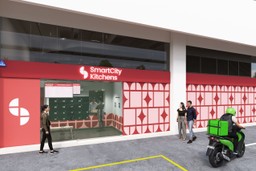For the most part, restaurants have offered near-identical dining experiences over the past few decades – and this comes as no surprise. The model has remained largely unchanged – restaurants consist of a kitchen area in the back and a dine-in seating area towards the front. For quicker dining options like take-out and delivery, you would typically have to go to fast-food-style restaurants. Here, the compromise on quality was more than evident.
In recent years, however, there’s been a massive shift in how we buy and consume our food. One study suggests that in recent years, both our expectations of food and food brands have drastically changed. We now expect more nutritious, casual, and convenient food options while we want more transparent and authentic brands that use organic and natural ingredients. A driving force in the industry, food technology has continually sparked innovations that cater to the F&B world we live in – one that requires convenient yet healthy, wholesome food options. Third-party delivery companies and CloudKitchens® delivery kitchens are two examples of this. Read on to find out exactly how new food technology changing the industry.
#1 Third-party Delivery Companies
Deliveroo. Foodpanda. WhyQ. The list goes on. You’ve probably heard many of these names before if not used their services already. Third-party delivery companies and new food technology have taken Singapore (and the rest of the world) by storm. Changing eating habits and the impacts of COVID-19 have seen dine-in fast on the decline, while the demand for high-quality food has increased.
These companies make their living by partnering with a wide range of restaurants across the country. After the food is prepared, it gets handed off to their courier service before being delivered to the customer’s door. For the customer, this is as easy as ordering directly from an app on their smartphone. The convenience and ease of it all is undoubtedly the greatest benefit – but people are also enjoying the luxury of eating quality food at a moment’s notice in the comfort of their own home.
Under the pandemic, more and more restaurants made the shift to this delivery-centric world. Now, customers can get high-quality food delivered to their door – food that is no different than what they would get for dine-in orders at a restaurant.
All of this was made possible by the prevalence of smartphones. They are the backbone of the entire food-delivery industry, while the apps and infrastructure created is another facet of food technology that has contributed to their eventual rise. But it isn’t all good news for restaurants in the industry. Change necessitates adapting – and some restaurants do this better than others. The biggest problem for many lies with their physical dine-in location. Seats are being left empty, yet dine-in customers are less frequent than before. The struggle to effectively capture the delivery market was an uphill battle for many restaurant businesses. They had to contend with high operational costs, mounting delivery orders, and an outdated infrastructure that couldn’t cope with the stress of new food technologies.
#2 Enter CloudKitchens® delivery kitchens
CloudKitchens® delivery kitchens, aka delivery-only kitchens themselves, are not a brand new idea. They have been around for years now but existed primarily as a more niche option for specific restaurants and brands that could fully utilise the benefits. Now, more and more brands are beginning to see precisely how delivery kitchens can help their restaurant adapt, grow, and find success in the new norm. So what exactly is it about them that makes them such an innovative food technology solution?
1. They offer the chance to boost profit margins
Delivery kitchens are typically run by an operator, such as Smart City Kitchens. They will handle all the construction, permits, and renovations, meaning upfront costs are far lower than opening a traditional restaurant space.
Since there is no dine-in space in delivery kitchens, there’s no need for front-of-house staff and no need to search for prime real estate right in the centre of town. This means lower operational costs each month, as your sole focus is fulfilling as many delivery orders as possible.
These two factors allow businesses to increase their profit margins and take control back of their own success.
2. They allow businesses to find more customers
Without the customer limitation of dine-in restaurants, your CloudKitchens® delivery kitchen can cater to a much larger number of hungry delivery customers. The only limit is the rate at which the kitchen receives orders and can cook the food.
3. CloudKitchens® delivery kitchen offer restaurants more flexibility
Moving into a CloudKitchens® delivery kitchen takes weeks, not months. This, coupled with the perks of renting the spaces from an operator, means that scaling up or down your business is simple and straightforward. Forget complex logistical and bureaucratic issues and instead focus on perfecting your recipes.
4. Businesses get access to new kitchen technology
Our CloudKitchens® delivery kitchen operates through a single tablet at the centre of each kitchen. With it, each restaurant can consolidate and manage all their orders through a single platform while also getting access to a dashboard full of insightful data.
Food technology like this is changing the way successful restaurants are run. This centralised platform allows you to immediately see the most popular dishes – giving you the most return on your investment. Optimisation is a natural progression after that.
Final thoughts
Food technology has been disrupting the traditional restaurant business model at an increasingly rapid pace. Changing habits and the onset of the pandemic have forced restaurants worldwide to adapt, and delivery companies and delivery kitchens have been the vehicle of this change.
To learn more about CloudKitchens® delivery kitchen and food technology, get in touch with Smart City Kitchens by filling out the form below. As industry experts, we’re more than happy to offer advice and potentially get you started with F&B innovations like delivery kitchens.


